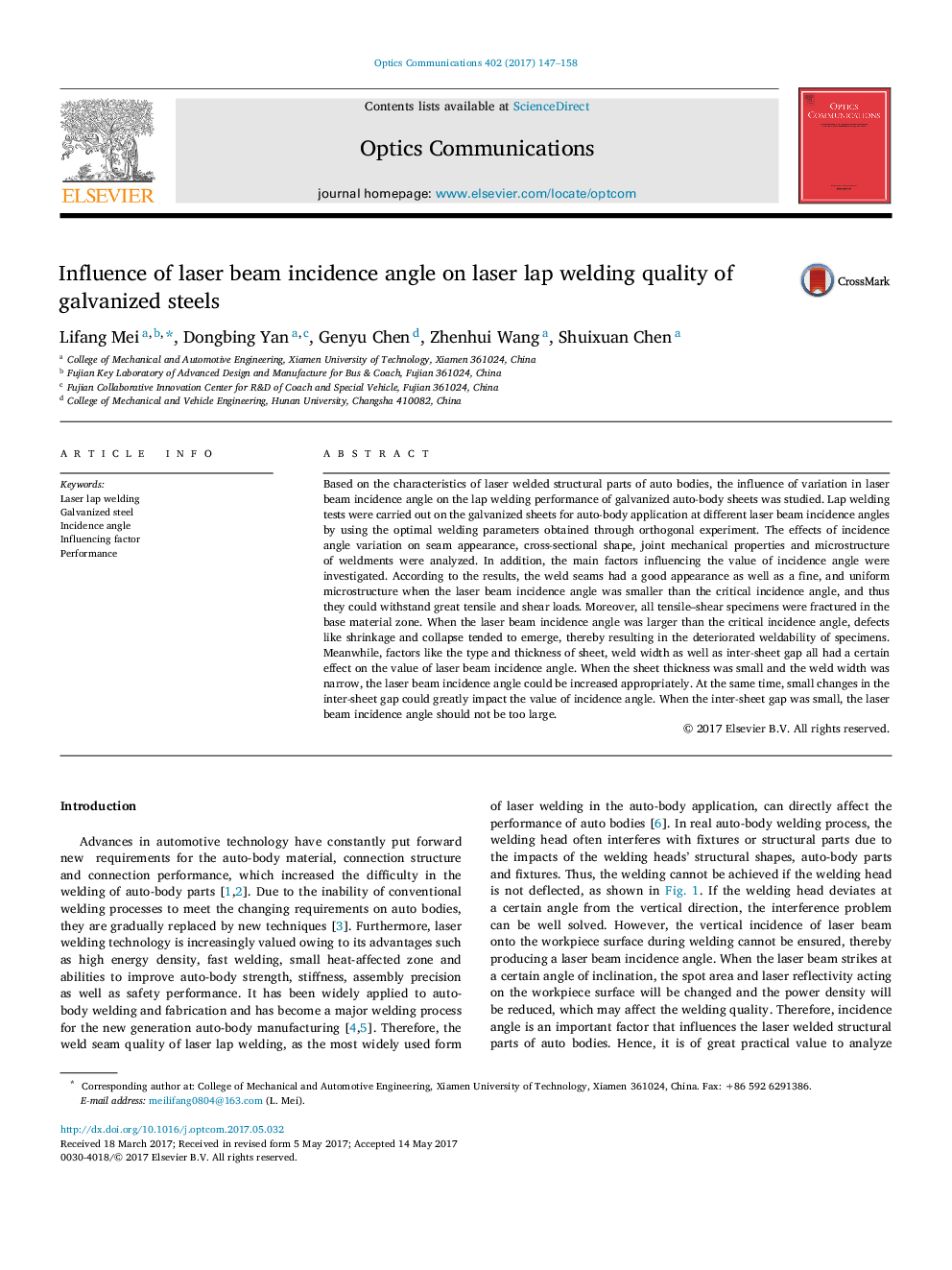| کد مقاله | کد نشریه | سال انتشار | مقاله انگلیسی | نسخه تمام متن |
|---|---|---|---|---|
| 5449105 | 1512521 | 2017 | 12 صفحه PDF | دانلود رایگان |
عنوان انگلیسی مقاله ISI
Influence of laser beam incidence angle on laser lap welding quality of galvanized steels
ترجمه فارسی عنوان
تاثیر زاویه برش لیزر بر کیفیت لیزر فولاد گالوانیزه
دانلود مقاله + سفارش ترجمه
دانلود مقاله ISI انگلیسی
رایگان برای ایرانیان
کلمات کلیدی
جارو برقی لیزر، فولاد گالوانیزه، زاویه بروز، عامل تاثیرگذار، کارایی،
ترجمه چکیده
بر اساس خصوصیات قطعات ساختاری لیزر جوش داده شده از بدنه خودرو، تاثیر تغییرات زاویه برش لیزر بر عملکرد جیپیاس ورق گالوانیزه خودرویی بررسی شد. آزمون های جوشکاری لیوان بر روی ورق های گالوانیزه برای کاربرد خودکار بدن در زاویه های مختلف برش لیزر با استفاده از پارامترهای جوشکاری مطلوب به دست آمده از طریق آزمایش متعامد انجام شد. اثر تغییرات زاویه بروز بر ظاهر جوش، شکل مقطع عرضی، خواص مکانیکی مفصلی و ریز ساختار جوش داده شده مورد تجزیه و تحلیل قرار گرفت. علاوه بر این، عوامل اصلی بر میزان زاویه بروز بررسی شد. بر طبق نتایج، درزهای جوش ظاهری خوب و همچنین ریز و ریز ساختار یکنواخت را داشتند زمانی که زاویه برش لیزر کوچکتر از زاویه یابی بحرانی بود و بنابراین می توانست بارهای کششی و برشی را تحمل کند. علاوه بر این، تمام نمونه های کششی برشی در منطقه مواد پایه شکست خورده اند. هنگامی که زاویه اشباع لیزر بزرگتر از زاویه بروز بحرانی بود، نقص هایی مانند انقباض و فروپاشی به وجود می آمد، و در نتیجه موجب بدتر شدن جوش پذیری نمونه ها می شود. در ضمن، عوامل مانند نوع و ضخامت ورق، عرض جوش و همچنین فاصله بین ورق همگی تأثیر خاصی بر مقدار زاویه برش لیزر داشتند. هنگامی که ضخامت ورق کوچک بود و عرض جوش آن باریک بود، زاویه اشباع لیزر می تواند به طور مناسب افزایش یابد. در عین حال، تغییرات کوچک در شکاف بین ورق می تواند تا حد زیادی بر میزان زاویه بروز تاثیر بگذارد. هنگامی که فاصله بین ورق کوچک بود، زاویه اشباع لیزر نباید بیش از حد بزرگ باشد.
موضوعات مرتبط
مهندسی و علوم پایه
مهندسی مواد
مواد الکترونیکی، نوری و مغناطیسی
چکیده انگلیسی
Based on the characteristics of laser welded structural parts of auto bodies, the influence of variation in laser beam incidence angle on the lap welding performance of galvanized auto-body sheets was studied. Lap welding tests were carried out on the galvanized sheets for auto-body application at different laser beam incidence angles by using the optimal welding parameters obtained through orthogonal experiment. The effects of incidence angle variation on seam appearance, cross-sectional shape, joint mechanical properties and microstructure of weldments were analyzed. In addition, the main factors influencing the value of incidence angle were investigated. According to the results, the weld seams had a good appearance as well as a fine, and uniform microstructure when the laser beam incidence angle was smaller than the critical incidence angle, and thus they could withstand great tensile and shear loads. Moreover, all tensile-shear specimens were fractured in the base material zone. When the laser beam incidence angle was larger than the critical incidence angle, defects like shrinkage and collapse tended to emerge, thereby resulting in the deteriorated weldability of specimens. Meanwhile, factors like the type and thickness of sheet, weld width as well as inter-sheet gap all had a certain effect on the value of laser beam incidence angle. When the sheet thickness was small and the weld width was narrow, the laser beam incidence angle could be increased appropriately. At the same time, small changes in the inter-sheet gap could greatly impact the value of incidence angle. When the inter-sheet gap was small, the laser beam incidence angle should not be too large.
ناشر
Database: Elsevier - ScienceDirect (ساینس دایرکت)
Journal: Optics Communications - Volume 402, 1 November 2017, Pages 147-158
Journal: Optics Communications - Volume 402, 1 November 2017, Pages 147-158
نویسندگان
Lifang Mei, Dongbing Yan, Genyu Chen, Zhenhui Wang, Shuixuan Chen,
